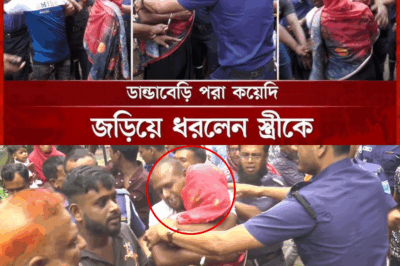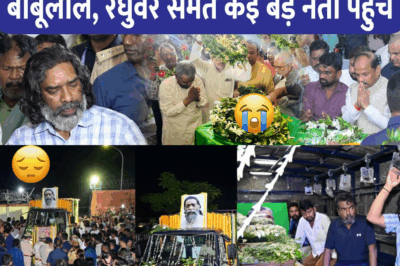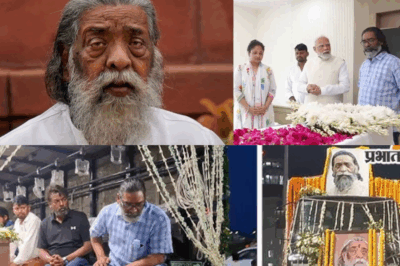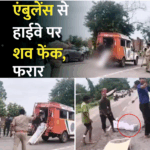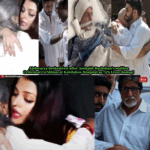Outrage in Gonda: Shocking Disrespect as Youth’s Body Dumped onto Road from Moving Ambulance
An incident so appalling and insensitive that it has left the entire nation stunned occurred in the Gonda district of Uttar Pradesh this week. CCTV footage and mobile videos circulating on social media captured a scene that stunned onlookers, exposed a deep crisis in our emergency and policing systems, and triggered uproar throughout the country.
The video, which has now gone viral, depicts an ambulance tearing down a main road with the body of a 24-year-old young man, Hriday Lal, hanging half-out of the vehicle. In one of the most disturbing moments ever to emerge from tragedy, the lifeless body—wrapped in a white shroud—was partially dragged along the street for several meters as relatives and police officers chased the vehicle on foot, desperately shouting for it to stop.
Tragedy Rooted in Violence
Hriday Lal’s ordeal began days before his death. On 1st August, a violent altercation erupted, reportedly over a financial dispute, leaving him gravely injured. He was rushed to a hospital in Lucknow. For three days, he battled for his life; his family prayed for a miracle. But on the morning of 4th August, he succumbed to his injuries. The loss devastated his relatives, pushing them to the brink of despair and anger.
Word quickly spread through Gonda that a young life had been extinguished, and soon, the police received alerts that tensions were rising. Reports suggested that agitated family members and local supporters were threatening to block the Lucknow-Gonda highway in protest, a move that could have led to widespread disruption and public unrest.
A Shocking Display of Inhumanity
After the completion of legal formalities—panchayatnama and post-mortem—the body was released to the family, accompanied by police officers. Hriday Lal’s remains were placed in an ambulance bound for Gonda.
No one could have anticipated what would happen next.
As relatives and police were gathered by the roadside attempting to reason with local crowds, the ambulance suddenly accelerated past them at high speed. Hanging out of the still-open back door was Hriday Lal’s body, visible to aghast onlookers and captured by multiple mobile cameras.
Within seconds, a man standing at the rear of the vehicle shoved the body off the moving ambulance, dumping it violently onto the tarmac. The vehicle did not stop. It sped away, leaving the body, family members, and police in shocked silence.
What followed was a scene of raw grief and unimaginable pain. As relatives rushed towards their loved one’s remains—now lying exposed in the middle of the street—women in the family collapsed in sobs, embracing the lifeless body clutching it to their chests. Furious locals shouted for justice; social media erupted in outrage, with millions expressing their disbelief and horror.
The Authorities’ Response
The Gonda Police were quick to respond, but many argued their actions came too late. Officers on the scene gathered the body and, with the family’s help, arranged for another vehicle to transport it for final rites.
The local police’s statement, delivered by Circle Officer (City) Anand Rai, attempted to shift the narrative. According to him:
“Influenced by some people, family members of the deceased attempted to take the body out of a running ambulance intending to block the national highway. This is visible in the viral video. Our police team quickly handled the situation, respectfully removed the body from the road, and helped take it home for the funeral. All four named accused from the earlier assault incident have been detained and further legal action is underway.”
However, glaringly missing from the statement was any mention of action against the ambulance driver or the individual seen forcibly pushing out the body. This omission has only fueled further anger—widespread calls for accountability and justice have dominated statements from politicians, activists, and everyday citizens alike.
A Funeral Amidst Chaos
Despite the mayhem and pain, Hriday Lal’s family, with the support of local authorities, managed to conduct the final rites. Grieving relatives and neighbors gathered to mourn a life lost too soon, and a farewell that—thanks to official and contractor negligence—became a symbol of systemic apathy rather than dignity.
The System On Trial
The incident is far more than an isolated act of disrespect or mismanagement. Social commentators and opposition leaders have pointed out that it reveals a larger rot in the state’s emergency services and law enforcement culture. “If this can happen under the eyes of police, with camera phones watching, what happens to the vulnerable when nobody is looking?” questioned local activist Sandeep Srivastava.
Legal experts are demanding a full investigation, not just into the original assault that took Hriday Lal’s life, but into how a system built to protect dignity could so catastrophically fail a citizen. “It is barbaric to treat any deceased person—no matter the circumstances—as disposable cargo,” argued lawyer Nidhi Verma on national television. “Dignity in death is a basic human right.”
Nationwide Outrage and Demands for Change
The video has trended across platforms, with hashtags like #JusticeForHridayLal and #GondaHorror calling for resignations and reform. Local politicians, including members of the ruling party, have promised inquiries and compensation, but skepticism remains high.
Meanwhile, the four accused in the original assault case have been arrested, but protests continue, especially over the lack of charges against the ambulance staff.
Its images of agony and public inhumanity have forced an uncomfortable reckoning for authorities: can bureaucracy ever excuse such a lack of basic compassion? How will future families be protected from such horror?
The Human Cost
It is easy to be lost in the statistics and statements, but the pain of Hriday Lal’s family cannot be measured. In one viral clip, a woman from the household can be heard crying: “What was his fault? Why was he treated like garbage?” The tears and testimonies have resonated with millions, uniting people from all walks of life under a single demand: Respect.
“Humanity has died today in Gonda,” wrote a schoolteacher from a neighboring town. “If a dead man is denied dignity, what hope is there for the living?”
Hope for Accountability
The District Magistrate’s office has now pledged to review ambulance policies and to consider severe penalties for companies and drivers who fail to uphold dignity. But for the Lal family, such promises sound hollow in the aftermath of such shocking trauma.
This tragedy is unlikely to be forgotten soon. As night fell in Gonda, candlelight vigils and silent marches began. Public anger remains high and, for now, it seems that only accountability and meaningful reform can heal the wounds left on one family—and on the conscience of a nation.
In the final analysis, the death of Hriday Lal is a tragic echo of systemic failures. A society is judged by how it treats its weakest and its dead. In Gonda, the world watched—and found us wanting. The call to do better, to uphold dignity and humanity above all, grows louder with every shared image, every grieving face, and every unanswered question.
News
The Final Salute: Jharkhand’s Epic Farewell to Shibu Soren, The Father of A Movement
The Final Salute: Jharkhand’s Epic Farewell to Shibu Soren, The Father of A Movement As the monsoon clouds gathered over…
harkhand Mourns: The Last Journey of Shibu Soren, Architect of a State and Voice of Its People
harkhand Mourns: The Last Journey of Shibu Soren, Architect of a State and Voice of Its People By [Your Name]…
Thousands Pay Last Respects as Jharkhand Mourns the Loss of Legendary Leader Shibu Soren
Thousands Pay Last Respects as Jharkhand Mourns the Loss of Legendary Leader Shibu Soren A wave of mourning swept across…
The Final Goodbye to Shibu Soren: Jharkhand’s People Unite in Unprecedented Mourning
The Final Goodbye to Shibu Soren: Jharkhand’s People Unite in Unprecedented Mourning Ranchi, Jharkhand – The sun set over Morabadi…
Veteran Leader and Former Jharkhand Chief Minister Shibu Soren Passes Away at 81
Veteran Leader and Former Jharkhand Chief Minister Shibu Soren Passes Away at 81 New Delhi: In a tragic development, senior…
Munawar Faruqui’s Viral Reaction Sends Abhishek Kumar and Isha Malviya’s New Song into Frenzy: Fans Predict a Superhit!
Munawar Faruqui’s Viral Reaction Sends Abhishek Kumar and Isha Malviya’s New Song into Frenzy: Fans Predict a Superhit! Introduction What…
End of content
No more pages to load


